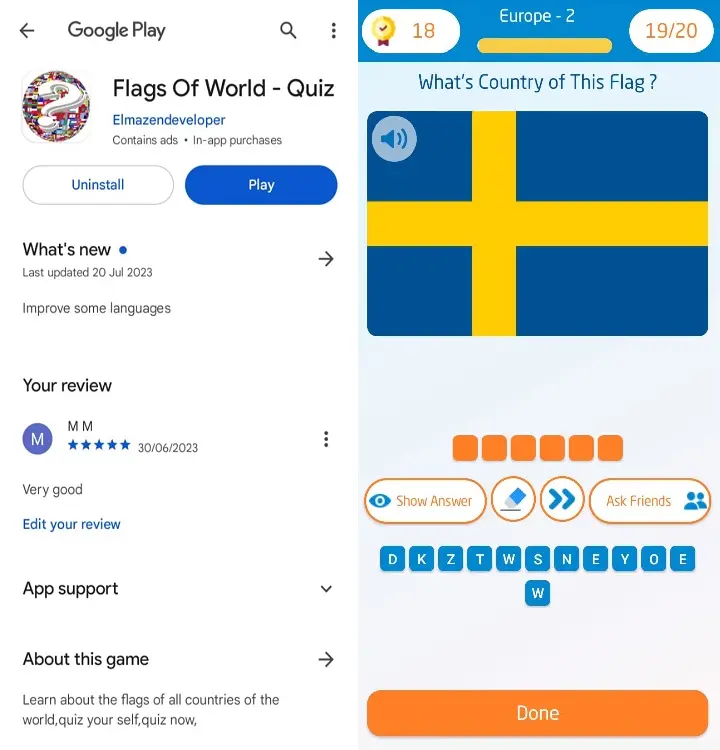- Details
- Written by: Elmazen
- Category: Flags of Countries of the World
- Hits: 803
Flag of Kosovo
Flag of Kosovo, Currency, Population, Tourist Places, Borders, Culture
Kosovo: A Glimpse into the Heart of the Balkans
Kosovo, a small yet fascinating country in the Balkan Peninsula, is rich in history, culture, and natural beauty.
Known for its resilience and the diversity of its landscapes, Kosovo offers travelers a unique blend of Eastern European and Mediterranean influences.
Here’s a look into the vital aspects of this nation.
Flag of Kosovo, Currency, Population, Tourist Places

Download the application  Flags Of World - Quiz ,
Flags Of World - Quiz ,
And test your knowledge with Flags of World ,
1. Population of Kosovo :
Kosovo is home to around 1.8 million people, with most residents concentrated in cities like Pristina (the capital), Prizren, and Peja.
The population is young, with about 65% under the age of 35, giving Kosovo one of the youngest demographics in Europe.
Ethnic Albanians make up the majority, followed by smaller communities of Serbs, Bosniaks, and Turks.
2. The Meaning Behind Kosovo’s Flag :
Kosovo’s flag is distinctive and symbolic.
It features a blue background with a golden map of Kosovo at its center, symbolizing the country itself.
Above the map are six white stars, representing the six major ethnic groups: Albanians, Serbs, Turks, Gorani, Roma, and Bosniaks.
This flag reflects Kosovo’s commitment to multiculturalism and coexistence among its communities.
3. Kosovo’s Currency :
The Euro (€) is the official currency of Kosovo, despite it not being a part of the Eurozone.
The use of the Euro has helped facilitate trade and travel within Europe.
It is widely accepted and simplifies transactions, especially for travelers coming from other European countries.
Flag of Kosovo, Currency, Population, Tourist Places

Download the application  Flags Of World - Quiz ,
Flags Of World - Quiz ,
And test your knowledge with Flags of World ,
4. Borders of Kosovo :
Kosovo is landlocked and bordered by several Balkan countries: Serbia to the north and east, Montenegro to the west, Albania to the southwest, and North Macedonia to the south.
Its location in the central Balkans has influenced its history, shaping its cultural and political identity.
5. Culture of Kosovo :
Kosovo’s culture is a blend of Albanian, Ottoman, and Serbian influences, visible in its language, art, architecture, and cuisine.
Albanian is the official language, but Serbian is widely spoken, particularly in Serb-majority areas.
Kosovars have a strong tradition of hospitality; guests are treated with warmth, and gatherings often involve traditional music, dance, and food.
Religious diversity is also prominent.
Islam is the majority religion, with Roman Catholic and Eastern Orthodox Christian minorities, each adding distinct cultural elements.
Traditional music, particularly folk songs and dances, plays a central role in celebrations, with instruments like the çifteli (a two-stringed instrument) being popular.
6. Best Places to Visit in Kosovo :
Kosovo offers many attractions for visitors:
Pristina :
The capital city is modern yet retains historical sites like the Kosovo Museum and the Newborn Monument, a symbol of the country’s independence.
Prizren :
Known as Kosovo’s cultural hub, Prizren boasts beautiful Ottoman-era architecture, cobblestone streets, and landmarks like the Sinan Pasha Mosque and Prizren Fortress.
Rugova Canyon :
Near Peja, this stunning canyon is perfect for nature lovers.
Its dramatic cliffs and hiking trails make it a popular destination for outdoor adventures.
Germia Park :
Located in Pristina, this park is ideal for relaxation, offering hiking trails, a swimming pool, and scenic picnic spots.
Gjakova’s Old Bazaar :
This bustling marketplace in Gjakova is among the oldest in the Balkans, with unique local crafts, cafés, and historic sites.
Brezovica Ski Resort:
In the Shar Mountains, Brezovica offers skiing and snowboarding in winter and hiking and mountain biking in summer.
Kosovo, though small, is a destination full of surprises, from its diverse culture and history to its breathtaking landscapes.
This welcoming and resilient nation provides a unique travel experience in the Balkans, making it a worthwhile addition to any European itinerary.
Flag of Kosovo, Currency, Population, Tourist Places

Download the application  Flags Of World - Quiz ,
Flags Of World - Quiz ,
And test your knowledge with Flags of World ,
- Details
- Written by: Elmazen
- Category: Flags of Countries of the World
- Hits: 909
Flag of the United Kingdom
Flag of the United Kingdom, Currency, Population, Tourist Places, Borders, Culture
Exploring the United Kingdom: Key Facts and Attractions
The United Kingdom (UK) is one of the world’s most historically rich and culturally vibrant countries, with a unique blend of tradition and modernity that makes it a fascinating destination.
Below is a detailed look at what makes the UK unique, covering everything from population to cultural highlights and popular tourist destinations.
Flag of the United Kingdom, Currency, Population, Tourist Places

Download the application  Flags Of World - Quiz ,
Flags Of World - Quiz ,
And test your knowledge with Flags of World ,
1. Population of the United Kingdom :
As of the October 2024, the UK has a population of around 69.2 million people.
This population is spread across four countries: England, Scotland, Wales, and Northern Ireland.
The majority of people reside in England, with London being the most populous city.
Other major cities include Manchester, Birmingham, Glasgow, and Cardiff.
2. United Kingdom Flag Meaning :
The UK’s flag, known as the Union Jack, combines elements of three older national flags:
St. George’s Cross (a red cross on a white background), representing England.
St. Andrew’s Cross (a white diagonal cross on a blue background), symbolizing Scotland.
St. Patrick’s Cross (a red diagonal cross on a white background), representing Ireland.
The combination reflects the union of these different nations under the United Kingdom, symbolizing unity and shared identity while also recognizing the individual histories and symbols of each country.
3. United Kingdom Currency :
The currency used in the UK is the British Pound Sterling (GBP), often symbolized as "£".
The pound is one of the world’s oldest currencies still in use and is known for its stability.
Although the UK was a member of the European Union until 2020, it retained its own currency rather than adopting the Euro, maintaining its economic independence.
Flag of the United Kingdom, Currency, Population, Tourist Places

Download the application  Flags Of World - Quiz ,
Flags Of World - Quiz ,
And test your knowledge with Flags of World ,
4. United Kingdom Borders :
The United Kingdom is an island nation located off the northwestern coast of mainland Europe.
It borders only one country by land:
Ireland : The UK shares a border with the Republic of Ireland on the island of Ireland.
The UK is otherwise surrounded by water: the Atlantic Ocean, the North Sea, the English Channel, and the Irish Sea.
Its geographical position has historically contributed to its naval power and influence on global trade and politics.
5. Culture of the United Kingdom :
The culture of the UK is diverse, with each country within the union contributing unique traditions, languages, and customs.
Some key aspects of UK culture include:
Language : English is the primary language, though Welsh, Scots Gaelic, and Irish are also spoken in respective regions.
Literature : The UK is famous for its literature, with authors like William Shakespeare, Jane Austen, and J.K. Rowling playing significant roles in world literature.
Music : The UK has produced numerous influential bands and musicians, including The Beatles, Queen, and Adele.
Cuisine : British cuisine includes classics like fish and chips, Sunday roast, and afternoon tea, but the food scene also reflects the UK’s multiculturalism, with Indian, Chinese, Italian, and other global cuisines widely available.
Festivals such as Glastonbury Festival and Notting Hill Carnival showcase the country’s love for music and diverse cultures, while historical events like Trooping the Colour celebrate royal traditions.
6. Best Places to Visit in the United Kingdom :
The UK is packed with famous landmarks, historical sites, and breathtaking natural scenery.
Here are some must-see destinations:
London : The capital city is home to iconic attractions like Buckingham Palace, the Tower of London, Big Ben, and the British Museum.
Edinburgh : Known for its historic and cultural festivals, particularly the Edinburgh Festival Fringe, Edinburgh also boasts Edinburgh Castle and stunning architecture.
Stonehenge : This ancient stone circle in Wiltshire, England, dates back to prehistoric times and remains one of the world’s most mysterious archaeological sites.
The Lake District : Known for its beautiful lakes, mountains, and outdoor activities, this national park in Cumbria attracts hikers, photographers, and nature lovers.
Giant’s Causeway : Located in Northern Ireland, this unique formation of hexagonal basalt columns is steeped in folklore and is a UNESCO World Heritage Site.
The Cotswolds : This charming area in south-central England is famous for its picturesque villages, rolling hills, and classic English countryside views.
The United Kingdom is a place where history meets modernity, making it a unique destination for visitors from around the world.
With its rich culture, iconic landmarks, and welcoming people, there’s always something new to discover in the UK.
Flag of the United Kingdom, Currency, Population, Tourist Places

Download the application  Flags Of World - Quiz ,
Flags Of World - Quiz ,
And test your knowledge with Flags of World ,
- Details
- Written by: Elmazen
- Category: Flags of Countries of the World
- Hits: 804
Flag of Ukraine, Currency, Population, Tourist Places
About Ukraine : -
Discovering Ukraine: People, Symbols, Borders, and Culture, Flag, Currency, Tourist Places
Flag of Ukraine, Currency, Population, Tourist Places

Download the application  Flags Of World - Quiz ,
Flags Of World - Quiz ,
And test your knowledge with Flags of World ,
1. Population of Ukraine :
Ukraine is the second-largest country in Europe by land area, following Russia, and has a significant population.
As of December 2024, Ukraine’s population stands at around 38.37 million people, though exact numbers fluctuate due to various factors, including migration and recent geopolitical developments.
The largest cities include Kyiv, the capital, along with Kharkiv, Odesa, and Dnipro.
2. Meaning of the Ukrainian Flag :
The Ukrainian flag consists of two horizontal bands: blue on top and yellow below.
This simple yet symbolic design carries a powerful meaning related to the Ukrainian landscape and cultural heritage.
The blue represents the sky, symbolizing peace and unity, while the yellow represents the golden wheat fields that are abundant across Ukraine.
Together, these colors reflect the country's rich agricultural land and aspirations for peace and prosperity.
3. Currency of Ukraine :
Ukraine's national currency is the hryvnia (UAH), which has been the official currency since 1996.
One hryvnia is subdivided into 100 kopiyok.
The currency’s symbol, ₴, is derived from a historic unit of weight used in ancient Kievan Rus.
The hryvnia showcases notable Ukrainian historical figures, further emphasizing Ukraine's commitment to its heritage.
Flag of Ukraine, Currency, Population, Tourist Places

Download the application  Flags Of World - Quiz ,
Flags Of World - Quiz ,
And test your knowledge with Flags of World ,
4. Ukraine's Borders :
Ukraine is bordered by several countries and has access to the Black Sea and Sea of Azov in the south.
The bordering countries include:
Poland, Slovakia, and Hungary to the west,
Romania and Moldova to the southwest,
Belarus to the north, and
Russia to the northeast and east.
The varied borders reflect Ukraine's history and the influence of both Eastern and Western European cultures.
5. Culture of Ukraine :
Ukrainian culture is a vibrant tapestry woven from rich folk traditions, language, arts, music, and literature.
Ukrainians have a strong sense of community and pride in their heritage, with family values playing a crucial role in daily life.
Traditional Ukrainian clothing, such as the vyshyvanka (embroidered shirt), is highly regarded, and the pysanka (decorative Easter egg) art form is internationally recognized.
Ukrainian cuisine is also a source of pride, with dishes like borscht (a beet soup) and varenyky (dumplings) symbolizing Ukraine’s agricultural bounty and culinary creativity.
Festivals are deeply rooted in Ukrainian culture, such as Ivana Kupala Day, a midsummer celebration with dancing, singing, and flower garlands, along with Christmas and Easter, celebrated with unique traditions and dishes.
6. Best Places to Visit in Ukraine :
Ukraine is rich with historical sites, natural beauty, and architectural wonders.
Some of the best places to explore include:
Kyiv :
The capital city, known for landmarks like the Kyiv Pechersk Lavra and St. Sophia’s Cathedral, both UNESCO World Heritage sites.
Lviv :
A culturally rich city in western Ukraine with well-preserved architecture, cobbled streets, and a strong coffee culture.
Odesa :
A port city along the Black Sea with beautiful beaches, the famous Potemkin Stairs, and lively nightlife.
Carpathian Mountains :
Known for their scenic beauty, the Carpathians offer hiking, skiing, and a chance to experience the traditional Hutsul culture.
Chernobyl Exclusion Zone :
A unique, location that allows visitors to see the site of the 1986 nuclear disaster, now with guided tours.
Kamianets-Podilskyi Castle :
A medieval fortress set on a rocky cliff, providing stunning views and insights into Ukraine’s military history.
Conclusion :
Ukraine is a country of remarkable resilience and cultural pride, with deep-rooted traditions, beautiful landscapes, and a unique identity shaped by centuries of history.
Whether you're interested in exploring its urban landmarks, tasting its traditional cuisine, or witnessing its diverse natural landscapes, Ukraine offers visitors an unforgettable experience that combines the past and the present.
Flag of Ukraine, Currency, Population, Tourist Places

Download the application  Flags Of World - Quiz ,
Flags Of World - Quiz ,
And test your knowledge with Flags of World ,
- Details
- Written by: Elmazen
- Category: Flags of Countries of the World
- Hits: 816
Flag of Switzerland, Currency, Population, Tourist Places
Exploring Switzerland: Facts, Culture, and Destinations
Switzerland, known for its stunning landscapes, high quality of life, and cultural diversity, is a small but influential country in Central Europe.
Here’s an in-depth look at some key facts about Switzerland, including its population, flag, currency, borders, culture, and top places to visit.
Flag of Switzerland, Currency, Population, Tourist Places

Download the application  Flags Of World - Quiz ,
Flags Of World - Quiz ,
And test your knowledge with Flags of World ,
1. Population of Switzerland :
As of December 2024, Switzerland’s population is approximately 8.94 million people.
The country has a moderate population density, with people mainly concentrated in cities like Zurich, Geneva, Basel, and Bern.
Switzerland has a high standard of living, attracting people from all over the world, which has led to a diverse population with a significant percentage of foreign residents.
2. Switzerland’s Flag and Its Meaning :
The Swiss flag is one of the most recognizable in the world, featuring a white cross on a red background.
Unlike most national flags, the Swiss flag is square.
The white cross represents faith and Christianity, while the red background is believed to signify freedom, honor, and bravery.
The flag's design is said to date back to the 13th century, representing Switzerland's tradition of neutrality and peace.
3. Switzerland’s Currency :
Switzerland’s currency is the Swiss Franc (CHF), which is also used in the neighboring principality of Liechtenstein.
The Swiss Franc is known for its stability, making it one of the world’s most reliable currencies and a popular choice for international investors, reflecting Switzerland's stable economy and robust financial system.
Flag of Switzerland, Currency, Population, Tourist Places

Download the application  Flags Of World - Quiz ,
Flags Of World - Quiz ,
And test your knowledge with Flags of World ,
4. Borders of Switzerland :
Switzerland shares borders with five countries:
Germany : to the north,
France : to the west,
Italy : to the south,
Austria : and Liechtenstein to the east,
These neighboring countries have had a significant influence on Switzerland’s culture, languages, and economy.
The Swiss Alps also form a natural border in the south, creating beautiful yet rugged terrain that’s iconic to Switzerland.
5. Culture of Switzerland :
Switzerland’s culture is a unique blend of influences from its neighbors and its own deeply rooted traditions.
The country has four official languages : German, French, Italian, and Romansh.
This multilingualism is reflected in Swiss art, literature, and media.
Traditions and Festivals : Switzerland has a variety of traditional festivals such as Fasnacht, the Swiss Carnival celebrated in Basel, and the Fête de l'Escalade in Geneva, commemorating the city’s resistance to invasion.
Cuisine : Swiss cuisine is influenced by French, German, and Italian culinary traditions.
Cheese fondue, raclette, and Rösti are among the popular dishes.
Chocolate is also a major highlight, with Swiss brands being recognized globally.
Outdoor Lifestyle : The Swiss are active and outdoorsy, often engaging in skiing, hiking, and mountaineering.
This is reflected in their appreciation for environmental sustainability and love for their natural landscapes.
6. Best Places to Visit in Switzerland :
Switzerland offers some of Europe’s most breathtaking destinations, combining natural beauty with historical and cultural landmarks.
Here are some must-visit places:
The Matterhorn :
This iconic, pyramid-shaped peak on the border with Italy is one of the most photographed mountains in the world and a popular destination for climbers.
Lake Geneva :
Situated between Switzerland and France, Lake Geneva is surrounded by vineyards, the city of Geneva, and the Swiss Riviera.
The Jet d'Eau fountain and the medieval Château de Chillon are highlights.
Jungfrau Region :
Known for its impressive mountains, including the Eiger, Mönch, and Jungfrau peaks, this region offers scenic train rides, hiking trails, and winter sports.
Zurich :
Switzerland's largest city is a financial hub, but it also boasts a picturesque old town, the famous Bahnhofstrasse shopping street, and a lively arts scene.
Lucerne :
With its charming lake, the Kapellbrücke (Chapel Bridge), and proximity to Mount Pilatus, Lucerne is a favorite among tourists seeking a mix of urban and natural beauty.
Bern :
Switzerland's capital is known for its medieval architecture, cobbled streets, and the Zytglogge clock tower, making it a UNESCO World Heritage Site.
Conclusion :
Switzerland’s combination of stunning landscapes, rich cultural diversity, and modern infrastructure makes it a top destination for travelers.
From the majestic Alps to charming medieval towns, Switzerland is a place where tradition meets innovation, and natural beauty meets cultural richness.
Whether you’re interested in outdoor adventures, historical sites, or simply exploring a well-organized and welcoming country, Switzerland has something for everyone.
Flag of Switzerland, Currency, Population, Tourist Places

Download the application  Flags Of World - Quiz ,
Flags Of World - Quiz ,
And test your knowledge with Flags of World ,
- Details
- Written by: Elmazen
- Category: Flags of Countries of the World
- Hits: 828
Flag of Sweden, Currency, Population, Tourist Places
Sweden: An Overview
Exploring Sweden : Population, Flag Meaning, Currency, Borders, Culture, and Must-Visit Places
Sweden, a Nordic country in Northern Europe, is known for its natural beauty, rich history, and modern, progressive culture.
From its breathtaking landscapes to its innovations in social welfare, Sweden is admired around the world.
Let’s explore the key aspects that define Sweden.
Flag of Sweden, Currency, Population, Tourist Places

Download the application  Flags Of World - Quiz ,
Flags Of World - Quiz ,
And test your knowledge with Flags of World ,
1. Population of Sweden :
As of December 2024, Sweden has a population of approximately 10.62 million people.
The population is relatively small compared to other European nations, yet Sweden is the largest of the Nordic countries by area.
It is known for its high quality of life, low population density, and focus on social welfare and equality.
2. Meaning of the Swedish Flag :
The flag of Sweden features a yellow or gold Scandinavian cross on a blue field.
The origins of the colors go back to the Swedish coat of arms, which has similar colors, with the blue symbolizing loyalty and truth and the yellow representing generosity.
The cross, common to many Nordic countries’ flags, reflects Sweden’s historical ties to Christianity and the unity of the Scandinavian region.
3. Sweden's Currency :
Sweden’s official currency is the Swedish krona (SEK), with "krona" meaning "crown" in Swedish.
Though a member of the European Union, Sweden has retained its own currency and has not adopted the euro, following a 2003 referendum where Swedes voted to keep the krona.
Flag of Sweden, Currency, Population, Tourist Places

Download the application  Flags Of World - Quiz ,
Flags Of World - Quiz ,
And test your knowledge with Flags of World ,
4. Borders of Sweden :
Sweden is bordered by Norway to the west and Finland to the northeast.
To the south, across the Öresund Strait, lies Denmark.
Sweden is surrounded by several bodies of water, including the Baltic Sea to the east and the Gulf of Bothnia between Sweden and Finland, providing the country with stunning coastlines and numerous archipelagos.
5. Culture of Sweden :
Swedish culture is known for its emphasis on equality, openness, and individualism.
The Swedes value privacy, and there's a strong sense of community.
Swedish society is based on principles like lagom, which means "just the right amount" and reflects the Swedish lifestyle of balance and moderation.
Another cultural pillar is fika, a tradition of taking a break with coffee and pastries, which is seen as essential to work-life balance.
In terms of art, Sweden has a thriving music industry, ranking as one of the top exporters of music worldwide.
Swedish pop music is popular internationally, with bands like ABBA and artists like Avicii achieving global fame.
Swedish design, known for minimalism and functionality, is celebrated worldwide, with IKEA being a prime example.
6. Best Places to Visit in Sweden :
Sweden offers many unique destinations, from bustling cities to serene natural landscapes:
Stockholm :
The capital city, known as the "Venice of the North," is spread across 14 islands and is home to iconic sites like Gamla Stan (the Old Town), the Vasa Museum, and the ABBA Museum.
Gothenburg :
Known for its maritime heritage, beautiful canals, and the Liseberg amusement park, Gothenburg has a relaxed, welcoming vibe with a lively arts scene.
Malmö :
Located in southern Sweden, Malmö is known for its blend of historic architecture and modern developments, like the Turning Torso skyscraper.
It's also connected to Denmark via the Öresund Bridge.
Swedish Lapland :
Ideal for nature lovers and adventure seekers, Swedish Lapland offers opportunities to witness the Northern Lights, experience dog sledding, and explore the Sami culture.
Gotland :
Sweden’s largest island, Gotland is famous for its medieval Visby town, a UNESCO World Heritage site, and beautiful beaches.
The Swedish Archipelagos :
The Stockholm and Gothenburg archipelagos consist of thousands of islands and islets, perfect for boating, fishing, and scenic retreats.
Conclusion :
Sweden is a country of remarkable contrasts and cultural richness, from the bustling cities filled with innovation to the tranquil beauty of the countryside and islands.
With a commitment to environmental sustainability, cultural heritage, and social equality, Sweden continues to stand out as one of the most admired countries in the world.
Flag of Sweden, Currency, Population, Tourist Places
